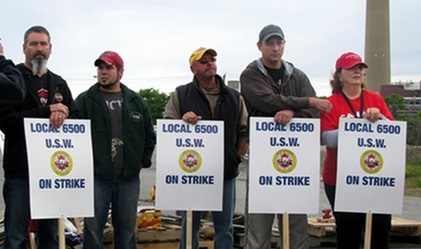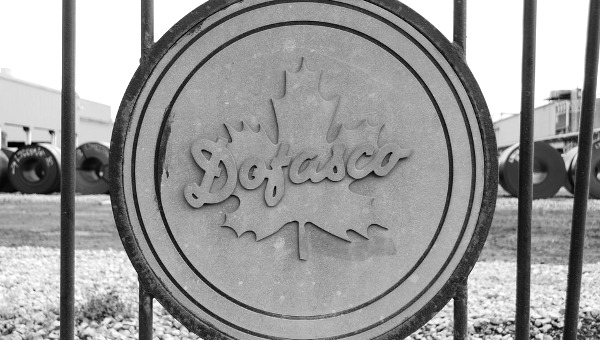Down in the Vale: Sudbury Steelworkers Strike at Vale Inco
For a valley so used to being torn up, spit out, and poisoned daily, everything is eerily quiet in and around Sudbury, Ontario these days. Beginning June 1st with a Vale Inco plant shutdown, that was then followed by a strike on July 13 when 3300 members of United Steelworkers of Canada (USW) Local 6500 rejected the concessionary demands of the Brazilian multinational subsidiary, the mines, smelter, mill, and refinery, and ‘superstack’ have all been closed. In addition, many mining supply and service companies are temporarily shuttered, idling thousands more usually employed in spin-off businesses.
It’s quiet in Port Colborne, Ontario and Voisey’s Bay, Newfoundland too. Both towns are also affected by strikes at Vale facilities – a refinery operation in Port Colborne, and a mine and nickel concentrator facility in Voisey’s Bay. This has put a further 600 USW workers on the picket line.
In Sudbury – as in other resource and manufacturing-based communities across Canada – the impact of the current global financial crisis is clear. People are out of work, and businesses are closing their doors. But in Sudbury, the effects can also be seen in the geography. There are no more holes being drilled. Nor are rock tailings being spread ever further across hundreds of kilometres of wasteland. There are also no nightly fiery pores of molten rock, lighting the evening sky.

Instead, most of the trains moving south out of Sudbury are running empty. Bars are quiet. Businesses are struggling. Even the ubiquitous, massive plume of sulphur dioxide and carcinogenic metals from the smelter on the edge of town has stopped.
It’s an abrupt turn around – even for a century-old mining town like Sudbury well-versed in the economic dynamics of ‘boom and bust.’ Over the past two years, Vale a Brazilian, global conglomerate made more than $4-billion in profit ripping and crushing some 500 million tonnes of rock into 170,000 tons of nickel metal. Millions of dollars more were made by local businesses supplying equipment, maintenance, and upgrades.
Nickel bonuses – once used to placate underpaid unionised workers – suddenly paid off ‘big’ – averaging as much or more than the Canadian full-time median income of $41,000 – as nickel prices rose three-fold to over $25 dollars a pound. Miners became six-figure earners and bought new houses, cars, trucks, and boats.
Now things are so quiet in the valley even Red Admiral and Painted Lady butterflies have returned. It’s not only in Sudbury that the ‘butterfly effect’ is being felt – but worldwide. The recent collapse of credit-default swaps and bogus collateralised debt obligations has led to an economic downturn that has caused a global flurry of job losses and layoffs.
The Economic Crisis and Unions
Because of the global financial crisis, the demand for minerals and natural resources has fallen. Raw-material prices have collapsed, and companies like Vale – which only six months ago were awash in billions of dollars in profit, are using the current downturn as a pretext to cut costs and jobs, and restructure collective agreements.
Businesses – that were supposed to be chastened and more ‘socially responsible’ in the wake of capitalism’s worst crisis since the depression – are suddenly seeing share prices rise, and are trying harder than ever to lower wages, cut benefits, and reduce their unionized workforces. Across North America, manufacturing companies under bankruptcy protection or facing debt default and government pressure to restructure, laid-off some 1.2 million workers between March 2008 and March 2009.
In the last fifteen months, more than seven million people in North America have been shown the door by employers. Already as a share of the workforce, more jobs have been lost in this recession than in any since 1957.
Labour unions have responded – some with a good deal of resistance. More Canadian unions are striking in the attempt to halt concessions. As Statistics Canada recently noted some 271,370 eight-hour work days were lost every month to work stoppages in the first quarter of 2009. This is almost double the 137,780 work days lost in the first quarter of 2008, before the recession started.1 In France, plant occupations have become the norm in firms about to close.
But the big question is: is this union effort enough? Because despite the efforts of workers, there is little evidence that the strike action and plant occupations have been anything more than ‘pissing in the wind.’
Workers may have enough moxie to go on strike during this recession, knowing that they are by no means the cause of the recent financial crisis. They may also have the courage – as in Sudbury – to simply walk away from the bargaining table when faced with major concessions to wages and benefits they have worked lifetimes to secure. But the eerie quiet in Sudbury, and the government support of business using billions in public money while telling workers to ‘tighten their belts,’ suggests the balance of power has shifted considerably.
Trade unions are now routinely vilified as ‘greedy’ for asking to retain wages, sick days, and pensions. And in the context of a recession caused by corrupt practices in financial markets, a rather strange scenario has unfolded – unionised workers rather than investment bankers are objects of resentment.
Now after a few short months, those who run the financial system are apparently little humbled. Claiming that the recession is ‘over,’ they are already chafing at ‘government interference,’ and talking about the need to cut social programme spending to reduce the deficit that the financial sector bailouts racked up.
With both the government and corporate deck stacked against them, workers are on the losing end – in terms of wages, jobs, benefits, and public support. Among many trade unionists and union leadership, there is a sense of tiredness – a sense that there is little fight left, no new strategies to put in play so workers can stand up and make the world a better place for all.
Outside of France, where ‘bossnapping’ and threats to blowup plants have become common tactics by workers facing shutdowns and job loss, the types of strikes and the kinds of mobilizing unions have undertaken can at best be described as underwhelming.
As a consequence, there’s more to the eerie quiet in Sudbury than closed mines and smelters. As in much of the rest of the world, there is also a sense that an era is over, that capital is winning hands down, and that organized labour had better get used to the idea.
Shock and Ore
Today, mining is a really big, really global business. In Northern Ontario, estimates peg the primary mining and metallurgical industry employing some 20,000 people and contributing some $9.4-billion in GDP annually to the Canadian economy.
This growth has been largely fuelled by China’s and India’s rapid industrialisation and their voracious appetite for metals. With the boom in China and Asia, which absorbed raw materials and pumped out finished products in everything from appliances to vehicles, the prices of most base metals soared to record peaks. Iron ore – used in steel production – doubled in price to $186 dollars a tonne 2002-2008. Nickel – a key component in stainless steel and the primary ore in the Sudbury basin – more than tripled from $7 to $25 dollars a pound.
The result was that mining companies achieved enormous profits and boasted gigantic valuations and subsequently underwent a series of outsized mergers and acquisitions over the past few years. Companhia Vale do Rio Doce (CVRD) (ie ‘Sweet Valley’ or Vale for short) is one such firm.
Vale entered into Canada in 2007, when it agreed to buy Inco Ltd. for $20-billion and establish an independent subsidiary, called ‘Vale Inco’ which is now the world’s second-biggest nickel producer. This was at the same time that other giant foreign multinationals were taking advantage of cheap financing to swallow up Canadian companies like Dofasco and Alcan.
Xstrata – a Swiss-based takeover firm founded in 1999 – also joined in the buying spree. On a $30-billion acquisition binge that added copper production in Chile, nickel mines in Canada, coal in Australia and platinum in South Africa, Xstrata snapped up Falconbridge (headquartered in Sudbury as well) for $17-billion.
But Vale – a massive industrial conglomerate – is a bit more complex than the usual mining giant. Vale/CVRD is actually a new corporate breed emerging out of the global South.
It operates in numerous countries around the world in a wide variety of forms, from direct ownership to joint ventures to setting up independent subsidiaries. Involved in everything from mining to railways, shipping to steel making, pulp and paper to reforestation and road building, the Brazilian corporation’s goal is diversification. The more commodities it churns out, the less its profits depend on the price of each one. The more able it is to control internal costs throughout its operations, the more its competitors will have to pay for ore and steel.
This has allowed Vale’s mother company to expand operations all along the production mining-steelmaking-transport chain. Through these joint ventures, Vale has ensured profits by processing and transporting ores produced by other companies.
Such strategies have paid off big for Vale and its subsidiaries. Vale Inco operations alone (some 10-20 percent of overall Vale/CVRD global operations), show that gross operating revenues achieved a historic high of $38.509-billion (U.S.) in 2008, up 16.3% from the $33-billion (U.S.) reached in 2007.
But the economics of mining changed with the financial crisis and the credit crunch that began last fall. Prices plunged as the world economy slumped and China’s red-hot growth cooled off. As prices fell, steelmakers cut production, affecting the amount of ore and processed metals they bought from the mining conglomerates.
Industry leaders such as ArcelorMittal, along with Chinese and Russian steelmakers, enacted production cuts of 10-15 percent or more. Consequently, in late May during the annual negotiations to fix a benchmark price for iron ore, the three biggest producers (Rio, BHP and Vale) had to take a price cut of 33 percent from Japan’s steelmakers, and Chinese producers are currently pressing for a 45 percent reduction in price. This after Vale had earlier offered a temporary 20 percent discount on 2008 prices.
Share prices have plunged too, so that net debt is well above firms’ market capitalisations. Borrowing levels that seemed manageable in the boom now look high.
As a consequence, even companies with comparatively low debt – like Vale, Anglo American, and BHP Billiton (an Australian mining giant which pulled out of a takeover of Rio, citing its debt) – have changed tactics. Now they are looking at aggressive cost cutting, by closing mines, putting off new capital projects, and in Vale’s case, attempting to lower unionized labour costs.
Over the past year, the mining industry has cut capacity remarkably quickly by idling mines and factories while mothballing others. Global capital expenditure is down by $15-billion or more. Such cuts will provide large enough savings to cashflows that they are likely to provide companies with the time to cover 18-24 months of interest costs. Most companies have sliced their capital budgets by between one-third and one-half.
Already this year, both Xstrata and Vale Inco announced mine closures in the Sudbury basin, and delayed their expansion plans. Vale Inco also went on an eight-week shutdown prior to the strike to cut production. Around the world, other mining companies are doing the same, with the expectation that production cuts will limit supply and inevitably push up prices in the short to medium-term.
Companies are also ‘pruning’ their workforces. Vale Inco reacted to the decline in nickel prices by cutting 900 jobs at its global nickel operations including 423 in Canada, and 261 of them in Sudbury.
The final means for reducing costs has been to squeeze workers and rework miners’ collective agreements. For Vale Inco this meant demands for several major concessions from the Sudbury, Port Colborne, and Voisey’s Bay workers. These concessions included: no increase in wages, though a cost-of-living clause was continued; a sharp reduction in the miner’s nickel bonus to 15 percent of the employee’s base pay (a bonus which was previously not capped); and a switch in the company’s pension plan from defined benefit to defined contribution.2 For workers, the net cost of these concessions would be tens of thousands of dollars in lost income and a far less secure and far smaller pension.
Wait and See
The USW Canada has wisely responded to these concessionary demands with ‘‘No,’ we’ll go on strike, and wait it out.’ The thinking was that as nickel inventories go lower and the price goes up, Vale Inco will soon realize that the costs of waiting far outweigh any of the benefits the company might receive from making the union local give in. The Steelworkers’ political response has been to highlight – through their political ally the NDP (New Democratic Party) – that Vale reneged on agreements made in 2007 with Ottawa under the Investment Canada Act to maintain job and production targets. It has claimed that Vale Inco has cut jobs earlier than agreed to, closed operations and put workers on strike to save on costs.
This has led to a heated public battle with Conservative Federal Industry Canada Minister Tony Clement. Despite the clear ‘strings attached’ under the 2007 agreement, Clement publicly backed Vale claiming that the company saved Sudbury from becoming a “Valley of Death,” and is doing more for jobs and investment in Northern Ontario than any other company. But whether either strategy is adequate remains an open question.
The USW was strategic enough to ensure that three of its Canadian collective agreements with Vale Inco all expired this summer, giving them leverage for their ‘wait it out’ strategy and the opportunity to bargain jointly on a common agreement. They have also recently signed a Solidarity Agreement with Brazil’s largest industrial union CUT, showing that unions can cooperate internationally to protect wages and working conditions.
Nonetheless, the past record of the USW (in the USA and Canada) in protecting jobs or wages is hardly auspicious of future success.
Over the past thirty years, in the steel industry, a sector that went through numerous restructurings, bankruptcies, and closures, the steelworkers sought to protect job security through consistent and patterned wage reductions in the 1980s and 1990s. However, while productivity increased, and by early 2000 profits improved, steel manufacturing experienced record job loss.
More recently, in the United States, the USW has pressed for ‘international champions’ to takeover failing plants, and then sought partnership agreements that typically traded wage and benefit concessions for job security. They have also sought to have U.S. governments uphold tariffs on steel imports from China and Western Europe, claiming ‘illegal’ dumping of low-priced products was responsible for the multiple bankruptcies in the U.S. steel industry. But the results have often been poor.
Tariff restrictions were quickly lifted. While new conglomerates failed to maintain employment and new investment, and union cooperation with management has only meant more contracting out, the speedup of work, job-loading, and more overtime for a few.
Added to these problems is the very limited public profile of both the USW and its political protector, the NDP. Outside of Sudbury, few have even heard of the strike. By today’s standards, and in comparison to the extraordinary well-resourced corporate communication campaigns, the NDP and the USW’s communication efforts and public advocacy campaign seem wholly inadequate, gaining little traction and support for their issues in the court of public opinion.
There are also problems with the USW community strategies. Traditionally, the Steelworkers and its affiliates are ‘top-down’ organizations, with modest member mobilizing, and little community organizing.
It is only now nine weeks into the strike – and following a two-month shutdown – that the Sudbury Steelworkers local with help from their international office, has begun to organize community committees and consider how to mobilize wider community and labour movement support.
The lack of a public/community mobilizing strategy has put the local well behind the ‘organizational eight-ball’ – a serious disadvantage in a strike that all observers predicted will be a long one. On top of this, the loss of USW 6500 hall in a fire last fall has created logistical issues for the local, such as where to conduct meetings, and headquarter the strike. Unlike the long and hard strike of the USWA against Inco in 1978-1979, there are few steelworkers actively working in the strike, and even fewer working in the community.
Conclusion
For a long time, the main criticisms of economic globalization were that it allowed companies to offshore jobs or to pick up and leave to more ‘business-friendly’ countries if taxes and labour costs were too high.
But the negative consequences of globalization have been much more than this. As the recent economic crisis and strike at Vale Inco well demonstrates, financial globalization has given investment banks and money traders the ability to make billions of dollars in stock and bond markets, and then get away with trillions more in public money to uphold bank and private-sector bailouts.
Financial deregulation and trade liberalization have also given multinational conglomerates (MNC) like Vale increased control over whole production sectors through the opportunity to buy out other businesses, restructure operations, and seek to lower labour costs by cutting good jobs and rewriting collective agreements along more favourable corporate lines.
Moreover, globalization has also meant more competitive pressures for companies and countries to do more of the same. Growing financial pressures from stocks and debt ensure that companies revamp their operations along more short-term ‘shareholder’ lines, maximizing finance and lowering labour costs, while diversifying and decentralizing operations.
Corporate success in enacting these strategies only feeds into a vicious cycle of intensifying competition which in turn compels further rounds of restructuring and further attacks on workers.
Sadly, with the economic deck stacked against them, unions have been largely unable to put up much of a fight to stop these trends.
In Sudbury, this same ‘ever-weaker David and ever-more-powerful Goliath’ scenario is now being played out. Regrettably, Vale Inco is in the ‘driver’s seat.’
Vale has deep pockets, and due to competition and huge market capitalization pressures, it is intent on lowering costs to boost returns and share prices. It has Federal government support too, and is looking to show even better profitability and more capital investment. The strike has cut into profits. But it has also allowed Vale to sit on ever more valuable inventories of ore. Low interest rates have allowed Vale to wait before swallowing up other companies in financial difficulty at a discount.
If it wins major concessions from the USW Local 6500, it will have more cash-flow to grow and restructure elsewhere. Like many MNCs in the world today, Vale has cash and a plan to succeed.
Strikes as at Vale Inco and the recent Canadian Union of Public Employees (CUPE) municipal disputes in Toronto and Windsor are a glimmer of the resistance that’s needed to expose the power multinationals and governments hold in the global economy. But strikes alone are not enough to counter the power of global firms and capitalist pressures. Substantive government policy shifts are needed to affect meaningful change. So too is a new political momentum and far better political strategies from within the labour movement
As the strike at Vale Inco has made it so painfully clear, we have a long way to go before the policy changes that will benefit workers are on the horizon. Sadly, the quiet we are experiencing in Sudbury seems only an ominous sign of more problems to come. •
Endnotes
- Kristine Owram, “Strikes rise despite recession,” Toronto Star, July 15, 2009.
- For the Steelworkers analysis of the collective agreement see, www.fairdealnow.ca.




